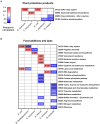High-throughput screening of the effects of 90 xenobiotics on the simplified human gut microbiota model (SIHUMIx): a metaproteomic and metabolomic study
- PMID: 38444810
- PMCID: PMC10912515
- DOI: 10.3389/fmicb.2024.1349367
High-throughput screening of the effects of 90 xenobiotics on the simplified human gut microbiota model (SIHUMIx): a metaproteomic and metabolomic study
Abstract
The human gut microbiota is a complex microbial community with critical functions for the host, including the transformation of various chemicals. While effects on microorganisms has been evaluated using single-species models, their functional effects within more complex microbial communities remain unclear. In this study, we investigated the response of a simplified human gut microbiota model (SIHUMIx) cultivated in an in vitro bioreactor system in combination with 96 deep-well plates after exposure to 90 different xenobiotics, comprising 54 plant protection products and 36 food additives and dyes, at environmentally relevant concentrations. We employed metaproteomics and metabolomics to evaluate changes in bacterial abundances, the production of Short Chain Fatty Acids (SCFAs), and the regulation of metabolic pathways. Our findings unveiled significant changes induced by 23 out of 54 plant protection products and 28 out of 36 food additives across all three categories assessed. Notable highlights include azoxystrobin, fluroxypyr, and ethoxyquin causing a substantial reduction (log2FC < -0.5) in the concentrations of the primary SCFAs: acetate, butyrate, and propionate. Several food additives had significant effects on the relative abundances of bacterial species; for example, acid orange 7 and saccharin led to a 75% decrease in Clostridium butyricum, with saccharin causing an additional 2.5-fold increase in E. coli compared to the control. Furthermore, both groups exhibited up- and down-regulation of various pathways, including those related to the metabolism of amino acids such as histidine, valine, leucine, and isoleucine, as well as bacterial secretion systems and energy pathways like starch, sucrose, butanoate, and pyruvate metabolism. This research introduces an efficient in vitro technique that enables high-throughput screening of the structure and function of a simplified and well-defined human gut microbiota model against 90 chemicals using metaproteomics and metabolomics. We believe this approach will be instrumental in characterizing chemical-microbiota interactions especially important for regulatory chemical risk assessments.
Keywords: SIHUMIx; chemical screening; chemical-microbe interaction; metabolomics; metaproteomics; microbiome-mediated toxicity.
Copyright © 2024 Castañeda-Monsalve, Fröhlich, Haange, Homsi, Rolle-Kampczyk, Fu, von Bergen and Jehmlich.
Conflict of interest statement
The authors declare that the research was conducted in the absence of any commercial or financial relationships that could be construed as a potential conflict of interest. The author(s) declared that they were an editorial board member of Frontiers, at the time of submission. This had no impact on the peer review process and the final decision.
Figures





Similar articles
-
The Simplified Human Intestinal Microbiota (SIHUMIx) Shows High Structural and Functional Resistance against Changing Transit Times in In Vitro Bioreactors.Microorganisms. 2019 Dec 3;7(12):641. doi: 10.3390/microorganisms7120641. Microorganisms. 2019. PMID: 31816881 Free PMC article.
-
Chemical mixture effects on the simplified human intestinal microbiota: Assessing xenobiotics at environmentally realistic concentrations.J Hazard Mater. 2024 Aug 5;474:134683. doi: 10.1016/j.jhazmat.2024.134683. Epub 2024 May 21. J Hazard Mater. 2024. PMID: 38820745
-
Environmentally Relevant Concentration of Bisphenol S Shows Slight Effects on SIHUMIx.Microorganisms. 2020 Sep 19;8(9):1436. doi: 10.3390/microorganisms8091436. Microorganisms. 2020. PMID: 32961728 Free PMC article.
-
Gut Microbiota and Short Chain Fatty Acids: Implications in Glucose Homeostasis.Int J Mol Sci. 2022 Jan 20;23(3):1105. doi: 10.3390/ijms23031105. Int J Mol Sci. 2022. PMID: 35163038 Free PMC article. Review.
-
Metaproteomic and Metabolomic Approaches for Characterizing the Gut Microbiome.Proteomics. 2019 Aug;19(16):e1800363. doi: 10.1002/pmic.201800363. Epub 2019 Jul 31. Proteomics. 2019. PMID: 31321880 Review.
Cited by
-
Shared Pathophysiology of Inflammatory Bowel Disease and Psoriasis: Unraveling the Connection.Cureus. 2024 Sep 3;16(9):e68569. doi: 10.7759/cureus.68569. eCollection 2024 Sep. Cureus. 2024. PMID: 39364475 Free PMC article. Review.
References
-
- Ampatzoglou A., Gruszecka-Kosowska A., Aguilera-Gómez M. (2022). Microbiota analysis for risk assessment of xenobiotics: toxicomicrobiomics, incorporating the gut microbiome in the risk assessment of xenobiotics and identifying beneficial components for one health. EFSA J. 20:e200915. doi: 10.2903/j.efsa.2022.e200915, PMID: - DOI - PMC - PubMed
Grants and funding
LinkOut - more resources
Full Text Sources

